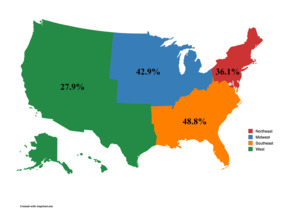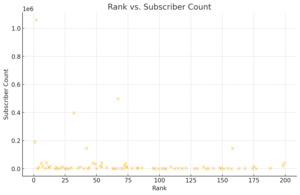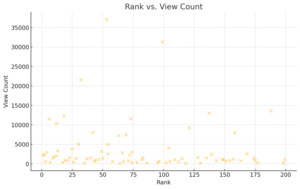INTRODUCTION
In the age of social media, many residency programs have turned to digital means of recruitment of medical students (Kim, Ali, and Vidal, n.d.). As electronic avenues such as YouTube, Instagram, and X (formerly known as Twitter) have increased in popularity, print forms of media such as newsletters and informational pamphlets have become less common methods of advertising residency programs to new recruits. Through maintaining a social media presence, residency programs might offer potential applicants a greater breadth of information regarding their programs, allowing applicants to make a more informed decision when submitting their residency match rank lists. Several studies have demonstrated an increase in the prevalence of residency-associated social media accounts coinciding with the COVID-19 pandemic (Ohnoutka et al. 2023).
Orthopedic surgery remains one of the most competitive fields to obtain a residency position, with greater than 1.6 applicants per position in the 2024 application cycle (National Resident Matching Program 2024). To navigate this extremely competitive environment, orthopedic residency programs must utilize all available means to ensure they recruit medical students that will best fit into their programs. A recent study found that out of 192 identified orthopedic surgery residency programs, 108 (56%) had an Instagram account, 65 (34%) had a Twitter account, and 58 (30%) had a Facebook account (Malyavko, Kim, Harmon, et al. 2021). A similar investigation determined that higher-ranking orthopedic residency programs, as determined by their Doximity ranking, and larger programs (>35 residents) were significantly more likely to have an Instagram or Twitter account (Ohnoutka et al. 2023). Recently, orthopedic residency applicants have expressed feeling a lack of transparency offered by residency programs, which has been validated by analysis of the offerings available through online informational databases such as FREIDA and Orthogate as well as program’s institutional websites (Malyavko, Kim, Harmon, et al. 2021; Davidson et al. 2016). These findings signify a need for better transmission of data about their institution’s offerings from residency programs to potential applicants.
A previous study demonstrated that higher ranking orthopedic residency programs were associated with increased social media engagement across Instagram and X (Joo et al., n.d.). Harnessing the recent influx of social media attention that residency programs have garnered, many orthopedic residency programs have turned to making recruitment videos via the social media platform “YouTube” to present themselves to medical students. The content of these videos often serves to display each residency program’s resources, curriculum, and mission in a way that allows medical students to discover which residencies may align with their personal goals within the field. With the establishment of online videos as a primary vehicle for medical student recruitment to orthopedic residency programs, it is imperative that we understand which programs are choosing to create these videos and for what reason. The purpose of this study was to determine which orthopedic residency program produced recruitment videos as well as what demographic factors about each program dictate a video’s popularity. We hypothesized that programs with higher Doximity ranking, and larger residency programs would be more likely to have YouTube recruitment videos to attract potential future residents.
METHODS
A cross-sectional analysis was conducted. The Accreditation Council for Graduate Medical Education (ACGME) website was used to identify all orthopedic surgery residency programs as of April 2024 (“List of Programs by Specialty” 2024). This list was cross-referenced with the Electronic Residency Application Service (ERAS) list of orthopedic programs accepting applications for the current cycle (ERAS Orthopedic Surgery Participating Programs 2024, n.d.). For each program, a Doximity ranking was recorded when available (“Doximity Orthopedic Surgery Program Residency Navigator” 2024). Doximity rankings are subjective rankings that are formulated based on evaluations and reviews submitted by practicing orthopedic surgeons, orthopedic fellows, and orthopedic residents, which are then voted on by the same populations (“Doximity Orthopedic Surgery Program Residency Navigator” 2024). Additionally, using a combination of each individual program’s website and various medical school websites, it was determined whether each program possessed an affiliation with an existing allopathic or osteopathic medical school. A Google search was utilized to identify YouTube accounts and associated recruitment videos for each residency program. The search consisted of (1) identifying related accounts through program or department websites and (2) entering the name of the department, program, or affiliated institute into two separate Google and YouTube searches with the attached string of “orthopedics,” “ortho,” “orthopedic surgery,” or “orthopedic residency.” Accounts were identified from the inception of the YouTube website (2005) until present (July 2024). Each identified YouTube account was evaluated to determine which videos were produced primarily with the purpose of residency program recruitment. The definition of a “residency recruitment” video for the purpose of this study was a video published by an orthopedic department’s YouTube account specifically with the intent of showcasing or offering more information about their residency program. Two independent authors (author initials blinded for peer-review) voted whether a video was intended to serve as a recruitment video based on this definition. No disagreements between the two authors were encountered. Factors such as posting title, video content, and context within the residency program’s YouTube account in its entirety were utilized to determine whether a specific video was intended to recruit medical students to that residency program. Once identified, engagement statistics for each residency program YouTube account were extracted, such as the number of recruitment videos, recruitment video view count and video length, and account subscriber count.
Statistical Analysis
Descriptive statistics were employed where appropriate using Microsoft Excel (Version 16.67; Microsoft Corp., Redmond, WA). Logistic and regression analyses were conducted with the use of SPSS Version 29.0 (IBM Corp., Armonk, NY). Categorical variables were analyzed using the Chi-Squared test when sample sizes were large enough, while the Fisher’s exact test was used when a Chi-Squared test may not be sufficiently powered. When comparing means, a two-sample unpaired T-test was conducted. An alpha level of .05 was considered statistically significant. Correlation coefficients (eg. “weak” versus “very weak”) were labeled in accordance with previously validated descriptions (Akoglu 2018).
RESULTS
Program Demographics
A total of 203 orthopedic surgery residency programs were evaluated for the presence of a YouTube recruitment video, with 79 (38.9%) programs identified as having at least one recruitment video. The average number of total residents (PGY-1 through PGY-5) per orthopedic residency program was 23.1 ± 9.4 residents. Increasing program size, as defined by total number of residents, was associated with an increased likelihood of having a recruitment video (p < 0.001). When stratified by geographical region, those in the Southeast exhibited the greatest proportion of programs possessing at least one recruitment video (21/43, 48.8%), followed by the Midwest (24/56, 42.9%) and the Northeast (22/61, 36.1%), while the West region had the lowest number of programs with a recruitment video (12/43, 27.9%) (Figure 1). There was no statistical difference (p = 0.208) in the proportion of residency programs with recruitment videos between regions. Of the 203 programs evaluated, 161 (79.3%) were determined to be directly affiliated with a medical school. There was no significant association between having a recruitment video and possessing a medical school affiliation (p = 0.312).
Logistic Regression Analysis
A weak, yet statistically significant relationship between Doximity ranking and having a residency recruitment video was found (coefficient = -0.0093, p < 0.001) with higher-ranked programs exhibiting an increased likelihood of publishing a recruitment video (Figure 2).
Correlation Analysis
A weakly negative correlation was found between a program’s Doximity rank and the length of their recruitment video (R = -0.258), with higher-ranked programs associated with longer video duration (Figure 3). There was also a weakly negative correlation found between Doximity rank and the number of subscribers to a program’s YouTube channel (R = -0.202) (Figure 4). A very weak negative correlation was found between Doximity rank and video view count (R = -0.074) (Figure 5).
DISCUSSION
The findings of this study indicate that only 39% of orthopedic surgery residency programs have a YouTube recruitment video. The presence of a recruitment video, increased video length, and greater number of channel subscribers were found to be weakly associated with a higher Doximity ranking. Furthermore, increasing program size was associated with increased likelihood of having a recruitment video, whereas no association was found between region or presence of affiliate medical school and likelihood of having a recruitment video.
Previous investigations into the use of social media by orthopedic residency programs yielded similar findings. A 2021 cross-sectional analysis by Malyavko et al (Malyavko, Kim, Harmon, et al. 2021). found a correlation between the presence of a social media account and a higher Doximity ranking. The authors investigated the use of Instagram, Twitter (now known as X), and Facebook by orthopedic surgery residencies in their efforts to recruit medical students and better publicize their programs. They found that over half (56%) of all programs had an Instagram account, with 34% and 30% having a Twitter and Facebook presence, respectively. Furthermore, higher-ranked programs were more likely to have an Instagram (p < 0.001), Twitter (p < 0.001), or Facebook (p = 0.002). This mirrors the findings of our study in which the presence of a YouTube recruitment video correlated with better a Doximity ranking (p < 0.001); however, the strength of the relationship identified in this study was minimal. The authors of the aforementioned study also found that the size of a program’s PGY-1 class correlated positively with the likelihood of having any of the three studied social media avenues (p = 0.019, 0.001, 0.008), a similar finding of our study in which larger programs were more likely to have recruitment videos (p < 0.001). The rationale for this finding may stem from the notion that larger programs have more resources available to invest into social media accounts and produce videos. A 2019 investigation of 16 specialties by Feinstein et al (Feinstein et al. 2019). found that program size was a significant predictor of Doximity ranking (p < 0.001). The authors postulated that this may be a result of a larger alumni pool available to respond to Doximity reputation surveys; however, the Doximity published methodology states that they correct for this confounder by weighing alumni votes against the pool of available physicians from the program of interest (“Doximity Orthopedic Surgery Program Residency Navigator” 2024). Other possible etiologies of this correlation include larger financial endowments and manpower available for research, leading to greater academic productivity. The cumulative findings of these investigations into social media use in orthopedic residency recruitment suggest that increased availability of resources, whether it be due to being a higher-ranked or larger residency program, may allow a more prolific presence on social media.
Our investigation into geographic distribution of recruitment tendencies yielded no significant association between region and likelihood of video recruitment. Previous investigation into the subject of social media and residency location found that programs in the “West South Central” region, defined as Arkansas, Louisiana, Oklahoma, and Texas, were more likely to have Twitter (p = 0.025) and Facebook accounts (p = 0.047) (Malyavko, Kim, Harmon, et al. 2021). The results of this study found no such association with states in the Southeast or West regions and YouTube account engagement metrics. One explanation for this discrepancy is that our methodology used a broader definition of region, therefore limiting potential findings on a smaller scale. Despite not reaching significance, our investigation found that there was a higher proportion of programs in the Southeast (48.8%) and Midwest (42.9%) regions possessing a recruitment video, suggesting there may be utility for a more in-depth study on geographic trends.
The findings of this study when taken in the context of previous studies suggest that larger, higher-ranked programs are using social media and video recruitment more than lower-ranked, smaller programs. Social media may serve as a vital marketing tool for lesser-known programs to recruit students that better match their strengths and goals. Perhaps paradoxically, larger, better-known programs have been shown to be the ones using these avenues to their advantage. Smaller programs and those that are lower ranked may benefit from implementing social media and YouTube recruitment as a means of attracting a broader candidate pool; however, it should be acknowledged that some of these programs may not have the resources available to do so. The overall benefit of recruitment videos is two-fold: 1.) videos allow programs to showcase themselves to a greater breadth of applicants, and 2.) by including the details of their particular program, institutions can attract residents that better fit with each individual program’s mission and focus. Future investigations into the utility of social media recruitment videos are necessary to better understand their utility, particularly with respect to smaller, lower-ranked institutions. A prospective analysis into the benefits of YouTube recruitment videos and similar forms of social media on residency ranking and candidate matching may provide significant insight to the benefits of social media in the orthopedic residency recruitment process. Additionally, it would be beneficial to examine the medical student perspective of what information they seek to derive from these types of media so that residency programs may optimize what information is included in their recruitment videos. Lastly, other forms of recruitment, such as residency open houses can be examined similarly to the methodology of this study, which will provide valuable information about another popular method of applicant recruitment in the orthopedic residency sphere.
Limitations
This study is not without limitations. Foremost, the possibility of human error in the identification and extraction of the data used for analysis is possible as in any study of this methodology. However, to mitigate this effect, multiple separate extractions were conducted by independent authors which were then reconciled to ensure consistency in the identification of residency programs and associated YouTube accounts and recruitment videos. Secondly, the definition of a YouTube recruitment video, defined as a video published specifically with the intent of offering more information about the orthopedic surgery department’s residency program, left margin for error in interpretation. Similarly, two independent authors graded a video as purposed for recruitment or not and any disagreements were resolved by a third independent author. Doximity rankings, while reasonably accurate and based on sound methodology, may not act as an entirely accurate data point when determining orthopedic residency program ranking. However, many prior studies have utilized similar methodology, which suggests that while not perfect, Doximity ranking still serves as the best indicator of residency ranking that is currently publicly available. Importantly, it should be acknowledged that YouTube, while the most popular avenue for hosting these videos, is not the only video-hosting website that might be used for recruitment video purposes.
CONCLUSION
Residency recruitment videos exist for only 39% of orthopedic residency programs. There does not seem to be an association between programs with an increased number of residents or a higher Doximity ranking and the likelihood of publishing these videos. Recruitment videos by higher ranking programs were not found to have a strong relationship with a greater view count, longer length of the video, or account subscriber count.




.png)





.png)

